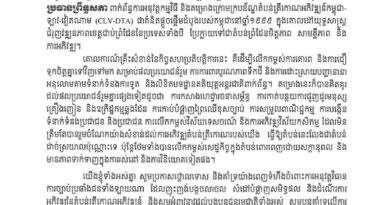ក្រុមអ្នកជំនាញនៃអាជ្ញាធរជាតិអប្សរាដែលសហការជាមួយទីភ្នាក់ងារសហប្រតិបត្តិការអន្តរជាតិកូរ៉េ(KOICA) តាមរយៈមូលនិធិបេតិកភណ្ឌកូរ៉េ(KCHF) កំពុងដំណើរការជួសជុលរចនាសម្ពន្ធមួយចំនួនរបស់ព្រះលានជល់ដំរី ដែលរងការខូចខាតឱ្យប្រសើរឡើងវិញ។
អ្នកគ្រប់គ្រងគម្រោងមូលនិធិបេតិកភណ្ឌកូរ៉េ លោក PARK JIMIN មានប្រសាសន៍ថា ការជួសជុលព្រះលានជល់ដំរីកំពុងធ្វើនៅទីតាំងចំនួន២ផ្សេងគ្នា គឺមួយស្ថិតនៅផ្នែកខាងជើង ប្រវែង២០ម៉ែត្រ និងមួយទៀត នៅផ្នែកខាងត្បូង ប្រវែង១៥ម៉ែត្រ។ ក្នុងដំណើរការជួសជុលក្រុមអ្នកបច្ចេកទេសផ្តោតការអនុវត្តលើការងារសំខាន់ៗមួយចំនួនដូចជា ពង្រឹងគ្រឹះ ពង្រឹងរចនាសម្ពន្ធពាក់ព័ន្ធផ្នែកខាងក្នុង និងខាងក្រោម ព្រមទាំងរៀបផ្គុំជញ្ជាំងនៃខឿនដែលទ្រេត និងថ្មពុកផុយឱ្យល្អឡើងវិញទៅតាមទម្រង់ដើម។
លោក PARK JIMIN បានឱ្យដឹងទៀតថា តាមការរកឃើញនៅទីតាំងទាំងពីរនេះ មានសភាពប្រហាក់ប្រហែលគ្នា គឺផ្ទៃជញ្ជាំងបានទ្រេតខ្លាំង អាចនឹងរលំ ព្រមទាំងថ្មបាយក្រៀម និងថ្មភក់ខ្លះបានពុកផុយបណ្ដាលមកពីអាយុកាល និងទឹកភ្លៀងហូរច្រោះខាងក្រោមធ្វើឱ្យគ្រឹះខាងក្រោមបាតបង់លំនឹង។
លោក ព្រំ ទិត្យឆពណ្ណរិទ្ធ ស្ថាបត្យករ និងជាក្រុមការងារបច្ចេកទេសនាយកដ្ឋានអភិរក្សប្រាសាទ និងបុរាណវិទ្យា នៃអាជ្ញាធរជាតិអប្សរាមានប្រសាសន៍ថា មូលហេតុសំខាន់ៗមួយចំនួនដែលធ្វើឱ្យគ្រឹះជញ្ជាំងស្រុត និងទ្រេតខ្លាំង ដោយសារតែគ្រឹះខាងក្រោមមានកន្លែងខ្លះស្រុត បណ្ដាលមកពីឬសឈើដុះចាក់ចូលទៅក្នុងរចនាសម្ពន្ធធ្វើឱ្យថ្មមួយចំនួនរំកិលចេញពីទីតាំងដើមបង្កើតបានជាប្រហោងនៅតាមចន្លោះថ្ម ជាហេតុធ្វើឱ្យទឹកហូរច្រោះចូលទៅតាមប្រហោងថ្មនាំល្បាយដីខ្សាច់ចេញមកក្រៅជាដើម។
ជាច្រើនខែមកនេះ ក្រុមអ្នកជំនាញបានរើថ្មកម្រាល និងជញ្ជាំងខឿនមួយផ្នែកដែលក្រៀកចេញ ដើម្បីពិនិត្យមើលស្ថានភាពជញ្ជាំងថ្មបាយក្រៀម និងរៀបថ្មភក់ ថ្មបាយក្រៀមទាំងនោះទៅតាមកន្លែងដើមឡើងវិញ ហើយចំពោះកន្លែងខ្លះដែលថ្មខូច គឺព្យាយាមជួសជុល ប៉ុន្តែ បើនៅតែមិនអាចជួសជុលបានទេ គឺត្រូវដាក់ថ្មថ្មីតិចតួចដើម្បីជំនួស៕
អត្ថបទ៖ ឆាយ ផាន់នី
រូបភាព៖ លោក ភោគ ជា
Experts from the APSARA National Authority, in collaboration with the Korea International Cooperation Agency (KOICA) through the Korea Cultural Heritage Foundation (KCHF), are restoring some damaged structures of the Terrace of the Elephants.
PARK JIMIN, Project Manager of the Korea Cultural Heritage Foundation, said the restoration is underway in two different parts, 20 meters in the north and 15 meters in the south. In the process of restoring, the restoration team focuses on the implementation of several important tasks, such as strengthening the foundations, strengthening the relevant structures inside and below, as well as reassembling the walls of the sloping platform and the corrugated stone.
Mr. PARK JIMIN said that the findings at the two sites are similar: the wall surface is very tilted and may collapse, as well as laterite and some sandstone has decayed due to age and rain. The bottom drain causes the bottom foundation to lose balance.
Mr. Prum Tith Chhapanrith, Architect of the Department of Conservation of Monuments and Preventive Archaeology of the APSARA National Authority, said that some of the main reasons why the foundations of the walls collapsed and tilted because the tree roots grow into the structure, causing some stones to move out of their original position, creating holes in the stone space, causing water to seep into the stone holes, bringing sand mixture out.
Over the months, experts have been removing part of the floor and walls to review the condition of the laterite walls and re-arrange the laterite sandstone to its original location and some of the damaged areas as well as to fix it, but if it still can not be fixed, a new stone will be replaced.
Article: Chhay Phanny
Photos: Phouk Chea





